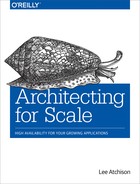0%
41Chapters
0-1Hours read
0kTotal Words
Book Description
Every day, companies struggle to scale critical applications. As traffic volume and data demands increase, these applications become more complicated and brittle, exposing risks and compromising availability. This practical guide shows IT, devops, and system reliability managers how to prevent an application from becoming slow, inconsistent, or downright unavailable as it grows. Author Lee Atchison provides basic techniques for building applications that can handle huge quantities of traffic, data, and demand without affecting the quality your customers expect.
Table of Contents
- Foreword
- Preface
- I. Availability
- 1. What Is Availability?
- 2. Five Focuses to Improve Application Availability
- 3. Measuring Availability
- 4. Improving Your Availability When It Slips
- II. Risk Management
- 5. What Is Risk Management?
- 6. Likelihood Versus Severity
- 7. The Risk Matrix
- 8. Risk Mitigation
- 9. Game Days
- 10. Building Systems with Reduced Risk
- III. Services and Microservices
- 11. Why Use Services?
- 12. Using Microservices
- 13. Dealing with Service Failures
- IV. Scaling Applications
- 14. Two Mistakes High
- 15. Service Ownership
- 16. Service Tiers
- 17. Using Service Tiers
- 18. Service-Level Agreements
- 19. Continuous Improvement
- V. Cloud Services
- 20. Change and the Cloud
- 21. Distributing the Cloud
- 22. Managed Infrastructure
- 23. Cloud Resource Allocation
- 24. Scalable Computing Options
- 25. AWS Lambda
- VI. Conclusion
- 26. Putting It All Together
- Index
